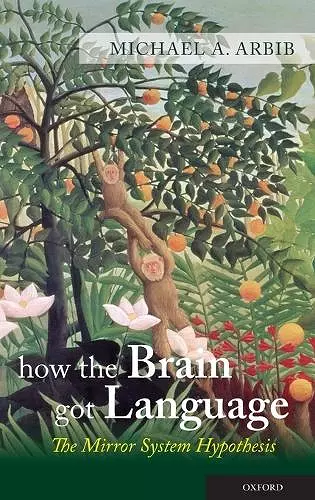How the Brain Got Language
The Mirror System Hypothesis
Format:Hardback
Publisher:Oxford University Press Inc
Published:5th Jul '12
Currently unavailable, and unfortunately no date known when it will be back

This book explains how the human brain evolved to make language possible and how cultural evolution took over from biological evolution during the transition from basic forms of communication to fully fledged languages. Basing his argument on the latest research in neuroscience, linguistics, and primatology, Michael Arbib presents an up-to-the-minute version of a theory that offers insights into the evolutionary importance of the brain's mirror neurons that enable monkeys, chimps, and humans to recognize the actions of others. Only in humans have these evolved to allow the "complex imitation" which supports the breakthrough to language. This theory, he shows, lights the path from the simple manual gesture we share with apes, to the imitation of manual skills and pantomime, and to the development of sign language and speech. It also explains why we can learn sign languages as easily as we can learn to speak. The author looks at how the brain mechanisms that made the original emergence of fully-fledged languages possible are still active in the ways that children acquire language today and sign languages continue to emerge. He also shows their crucial role in the processes by which languages change on time scales from decades to centuries. This book explains how the brain evolved to make language Michael Arbib provides nonspecialist readers with all the necessary background in primatology, neuroscience, and linguistics. His compelling account of this fascinating subject is fully accessible to a general audience.
A stimulating review of recent thinking on language evolution along with the most complete explication to date of his mirror system hypothesis, which has been presented in several recent articles...The theoretical breadth is impressive [and it] will be accessible to readers with different backgrounds. I recommend Arbibs book to serious students of language evolution and it should be a valuable resource. * PsycCritiques *
Arbib's book copiously illustrates the interdisciplinarity of research on language evolution, drawing on data from neuroscience, etholohy, linguistics, human palaeontology and prehistoric archaeology. * Kerstin Hoge, Times Literary Supplement *
Arbib's book is well written and engaging. Especially the chapters dealing with mirror neurons and how they function are very interesting. * Fredrik Heinat, Nordic Journal of Linguistics *
ISBN: 9780199896684
Dimensions: 165mm x 236mm x 28mm
Weight: 757g
432 pages